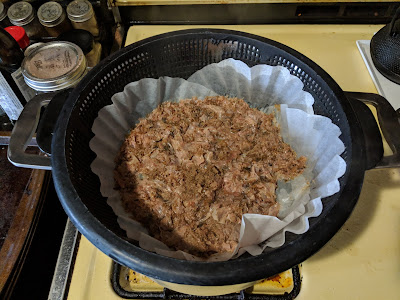Near-ubiquitous in Japanese cuisine, dashi ranks alongside rice and soy sauce in prominence -- it is difficult to find a Japanese meal which does not include at least of one of these three ingredients. Dashi is to Japanese cuisine what court-bouillon is to French; it is essentially a fish stock, made from boiled kombu-enriched water and the shavings of smoked and dried skipjack tuna, called katusobushi (鰹節).
Add water to large sauce pan. Add pre-cut kombu to water, submerging with a spoon, and then apply medium high heat.
Shave a block of katsuobushi on your kitchen's kezuriki (けずりき).
Collect the kezurikatsuo (けずりかつお - the katsuobushi shavings) from the kezuriki's drawer.
Remove the kombu and then cut the heat. Add the kezurikatsuo. The flakes should settle under the water.
After a few minutes (no more than three), pour the dashi carefully through a sieve or filter. The boiled kezurikatsuo may be saved and dried out to be applied as flavorful flakes to dishes (especially rice).
Umami-rich dashi.
Preparing the Katsuobushi:
Katsuo (skipjack tuna) has been caught and eaten in Japan since ancient times.
It is prized for its tender flesh, which, unfortunately, spoils easily. As a result, the southern coastal cities of Japan which specialized in catching the fish had to come up with ways to preserve it for its trip inland: some methods involved burying the fish in rice (the origin of sushi); other methods called for pickling the tuna; and yet others called for the fish to be smoked, thus drying out the flesh into very hard blocks.
The fish is caught and gutted. It is split into quarters lengthwise, and the bones are removed by hand. The fillets are laid in rows and immersed in hot water, and then coated in a paste to keep them from cracking while smoking in the smokehouse.
Katsuobushi which is meant to make dashi undergoes a near-six month process of drying out the fillets in smokehouses and under the sun in order to draw out all the moisture.
The result is a rock-hard block of tuna, literally the "hardest food" on earth. These are shaved like blocks of wood using an instrument called a kezuriki, and the shavings (kezurikatsuo) are used to make dashi.













No comments:
Post a Comment